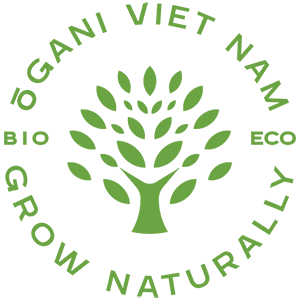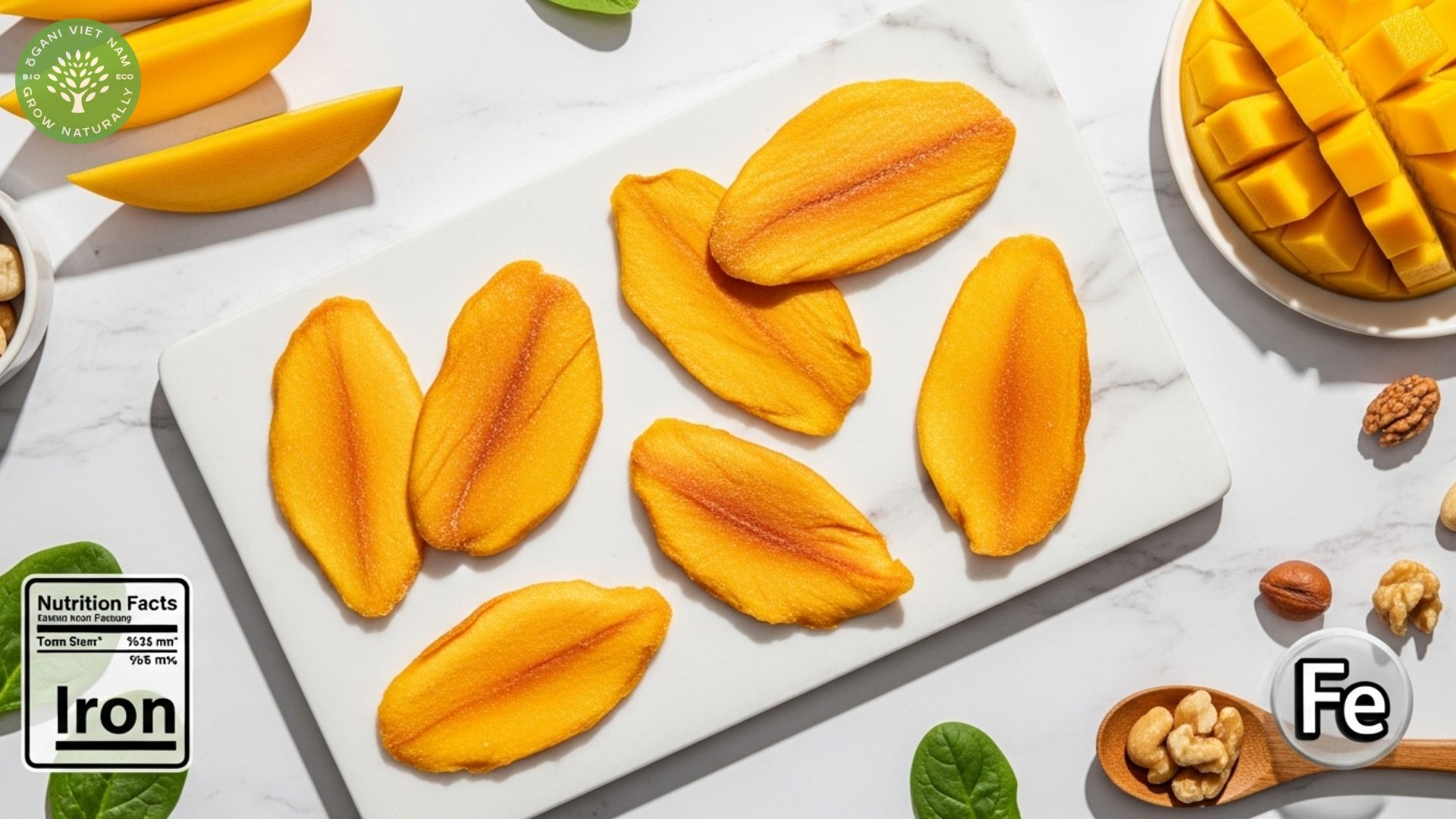At Ogani VN, we understand your concerns about getting enough iron from dried fruits. Dried mango iron content ranges from 0.3 to 2.4 mg per 100 grams, depending on the processing method and brand. While dried mango isn’t the highest iron source among fruits, it still contributes meaningfully to your daily iron intake when combined with other nutritious foods.
What affects dried mango iron content in different varieties?
When mangoes are dehydrated, their iron concentration increases significantly compared to fresh fruit. Fresh mangoes contain only about 0.16 mg of iron per 100 grams, while dried mango iron content can be 2-15 times higher due to water removal and concentration of nutrients.
The drying process removes approximately 80-85% of the mango’s water content, which naturally concentrates all remaining minerals including iron. However, some commercial brands add sulfur dioxide as a preservative, which can slightly reduce iron availability. Organic, unsulfured varieties typically maintain better mineral profiles.
Different processing methods also affect iron levels. Sun-dried mangoes often retain more natural iron compared to those processed with high heat or chemicals. At Ogani VN, we’ve noticed customers prefer naturally dried varieties not just for better iron content, but also for superior taste and texture.
How dried mango iron content meets your daily nutritional needs
Most commercial dried mango products provide between 0.3-0.6 mg of iron per 100-gram serving, which represents about 2-4% of your daily iron needs. However, premium organic varieties can contain up to 2.4 mg per 100 grams, reaching 15% of daily requirements.
To put this in perspective, a typical snack portion of dried mango (about 40 grams) delivers approximately 0.12-0.96 mg of iron. While this might seem modest, dried mango’s high vitamin C content actually enhances iron absorption in your body, making it more bioavailable than iron from many other plant sources.
Women aged 19-50 need about 18 mg of iron daily, while men require 8 mg. Children’s needs vary by age, typically ranging from 7-15 mg daily. Dried mango iron content alone won’t meet these requirements, but it serves as a valuable supplementary source, especially when paired with other iron-rich foods.
Comparing dried mango iron content with other dried fruits
Among dried fruits, mango falls in the middle range for iron content. Here’s how dried mango iron content compares to other popular options:
Dehydrated papaya leads with 3.2 mg per 100 grams, followed by dried apricots at approximately 2.7 mg. Dried mango iron content at 1.2 mg ranks similarly to dried bananas (1.15 mg) and dried apples (1.1 mg). Raisins provide about 1.88 mg, while dates offer around 0.9 mg per 100 grams.
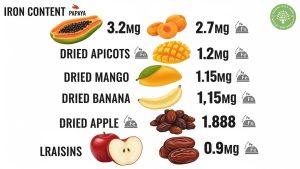
What makes dried mango special isn’t just its iron content, but the combination of iron with vitamin C, which significantly improves absorption. Many other dried fruits lack this synergistic vitamin combination, making their iron less bioavailable despite higher numerical values.
The natural sugars in dried mango also provide quick energy, making it an excellent choice for athletes or anyone needing sustained energy along with iron supplementation. This dual benefit sets it apart from iron supplements or other dried fruits that may cause digestive discomfort.
Maximizing absorption from dried mango iron content naturally
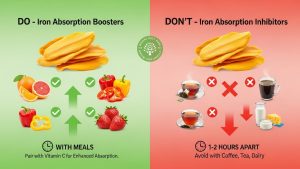
Understanding how to optimize dried mango iron content absorption can significantly improve its nutritional benefits for your body.
Combine with vitamin C-rich foods
Since dried mango already contains vitamin C, you’re getting natural absorption enhancement. However, pairing it with additional vitamin C sources like citrus fruits, bell peppers, or strawberries can further improve iron uptake by up to 300%.
Avoid iron inhibitors
Certain foods can reduce iron absorption from dried mango iron content. Coffee, tea, and dairy products contain compounds that bind with iron, making it less available to your body. Try to consume these items at least 1-2 hours before or after eating dried mango.
Time your consumption strategically
Iron absorption is highest when your stomach is empty or when consumed with light meals. Consider having dried mango as a mid-morning or afternoon snack rather than immediately after heavy meals containing calcium or whole grains.
Health benefits beyond dried mango iron content
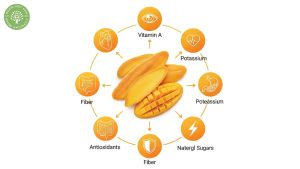
While dried mango iron content is valuable, this nutritious snack offers numerous additional health advantages. Each 100-gram serving provides significant amounts of vitamin A (supporting eye health), potassium (for heart function), and dietary fiber (promoting digestive health).
The antioxidants in dried mango, including beta-carotene and mangiferin, help protect cells from oxidative damage. These compounds work synergistically with iron to support overall immune function and energy metabolism.
For people with mild iron deficiency or those looking to prevent deficiency, dried mango serves as a pleasant, natural option. Unlike iron supplements that can cause stomach upset, dried mango provides iron in a gentle, easily digestible form while delivering additional nutritional benefits.
Frequently Asked Questions
How much dried mango should I eat daily for iron benefits? A serving of 40-50 grams (about 1/4 cup) provides optimal iron benefits without excessive sugar intake. This amount delivers approximately 0.5-1.2 mg of iron depending on the brand.
Is dried mango better than fresh mango for iron? Yes, dried mango iron content is concentrated and typically 2-15 times higher than fresh mango due to water removal during the drying process.
Can dried mango help with iron deficiency anemia? While dried mango contributes to iron intake, it shouldn’t be the sole treatment for iron deficiency anemia. Consult your healthcare provider for appropriate treatment and use dried mango as part of a comprehensive iron-rich diet.
Does organic dried mango have more iron? Organic varieties often have slightly higher iron content and better bioavailability since they’re processed without chemicals that might interfere with mineral absorption.
Making dried mango part of your iron-rich lifestyle
Dried mango iron content makes it a valuable addition to your daily nutrition routine, providing 0.3-2.4 mg of iron per 100 grams along with absorption-enhancing vitamin C. While it won’t single-handedly meet your iron needs, it serves as an excellent supplementary source that’s both delicious and nutritious.
At Ogani VN, we encourage incorporating dried mango into a balanced diet rich in various iron sources. Whether you’re looking to prevent iron deficiency, support energy levels, or simply enjoy a healthy snack, our premium dried mango products deliver consistent quality and nutritional value. Contact us today to explore our selection of organic, naturally processed dried mangoes that maximize both flavor and iron content for your health goals.
Read more:
- Dried Mango Nutrition Facts: Complete Guide To Calories, Benefits & Health Impact
- Best Dried Mango No Sugar Added: Premium Quality Guide
- Calories In Dried Mango No Sugar Added: Complete Nutrition Guide
- Are Dried Mangoes Good For You? The Complete Health Guide
- Benefits Of Dry Mango: Ultimate Health Guide For Natural Energy
